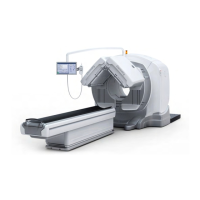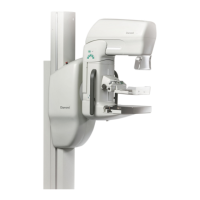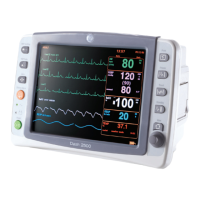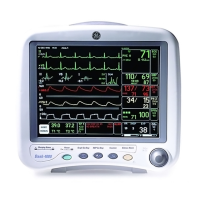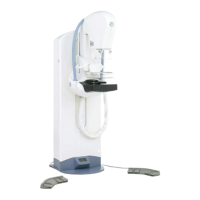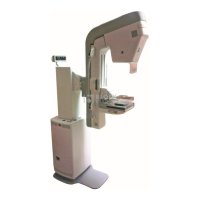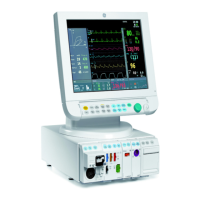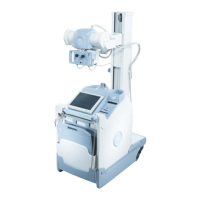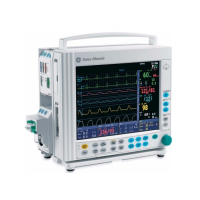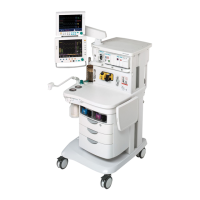Do you have a question about the GE Discovery LS and is the answer not in the manual?
Details the essential skills and tools required for system installation and service.
Provides critical safety procedures for disconnecting power and energy sources.
Covers safety procedures and considerations specific to the CT component.
Details operational safety guidelines when all system covers are in place.
Identifies primary hazards like X-rays and laser alignment lights.
Explains various labels, lights, and lamps used to promote safety awareness.
Describes the function and use of E-Off, E-Stop, and latching mechanisms.
Provides safety guidelines for servicing CT equipment, including hazards.
Details general safety aspects and electrical hazards within the CT gantry.
Covers safety precautions when working with the gantry, emphasizing electrical hazards.
Highlights electrical hazards and necessary precautions for the CT gantry.
Explains labels and indicators related to electrical hazards in the gantry.
Describes the location and purpose of the service outlet.
Lists and describes the gantry's service switches and circuit breakers.
Identifies mechanical hazards within the gantry that can cause personal injury.
Covers safety precautions when handling chemicals and materials used in service.
Details electrical and mechanical hazards associated with the patient table.
Highlights lethal voltages and potential electrical hazards on the table base.
Addresses mechanical hazards related to table touch sensors and operation.
Emphasizes safety precautions for handling chemicals during service.
Describes the console's power switch and related safety information.
Details safety precautions for working with PDUs, including potential hazards.
Explains CPDU features, hazards, and circuit breaker functions.
Describes NGPDU features, hazards, and circuit breaker functions.
Covers safety signal words, definitions, and labels for PET system components.
General safety information regarding signal words and label locations.
Defines DANGER, WARNING, and CAUTION signals and their color coding.
Illustrates and describes various safety labels found on the system.
Details electrical hazard labels and their locations on the PDU and gantry.
Describes labels related to mechanical hazards like moving fans and parts.
Illustrates and explains labels related to laser radiation hazards.
Describes labels related to radioactive pin handling and dose rate increase.
Covers safety aspects specific to the combined CT-PET system.
Details safety measures for CT-PET gantry operations and movement.
Highlights safety precautions for table movement and positioning.
Lists safety labels specific to the CT-PET system.
Provides an overview of the Discovery LS system and its capabilities.
Describes the major components and functionality of the CT imaging system.
Details the subsystems and functionality of the Advance PET imaging system.
Specifies the electrical power requirements for both CT and PET systems.
Describes the patient table's role in positioning for CT and PET acquisitions.
Explains how to access the PET gantry for service purposes.
Details the network architecture integrating CT and PET systems.
Describes the integrated hardware Emergency Stop circuit for CT and PET.
Outlines the features and design of the system covers for protection and ventilation.
Provides a step-by-step guide for powering up the PET-CT system.
Details the procedures for shutting down the PET-CT system and applications.
An overview of the Service Desktop, its access, and home page.
Details the nine major functional tools available within the Service Desktop.
Explains the differences in functionality for various user types and mouse functions.
Describes how to change desktops and manage windows using Cleanup and Reset.
Details the three functional subsystems of the console: CT Host, SRU, and PET Workstation.
Provides diagrams and descriptions of console component connections.
Describes the patient table's movement axes and functional components.
Provides an overview of patient table movement and configurations.
Details the parts of the manual CT-PET table assembly.
Provides instructions for upgrading a manual table to an automated version.
Lists the necessary FMIs and software requirements before starting the upgrade.
Details steps to prepare the system for the table base upgrade.
Provides step-by-step instructions for mechanical installation procedures.
Instructions on how to remove metal and side elevator covers from the table.
Details the removal of cover brackets from the ETC chassis.
Instructions for installing the mechanical stop assembly on the secondary base.
Steps to remove KB Box, cables, pedal assembly, and switches.
Detailed instructions for installing new hardware for the automated table base.
Procedure for drilling and tapping holes based on the secondary base rail revision.
Guides on determining the secondary base rail revision by counting access holes.
Instructions for attaching the CT template and drilling holes for rail attachment.
Procedure to determine PET detent location based on scan plane distances.
Steps for attaching the PET template and drilling detent holes.
Instructions for fastening the PET detent offset template to Revision 3 rails.
Instructions for fastening the PET detent offset template to Revision 0, 1, or 2 rails.
Procedure for drilling new PET detent holes closer to the CT detent.
Procedure for drilling new PET detent holes further from the CT detent.
Steps for installing the new clutch motor assembly.
Instructions for installing the table bulkhead if required.
Procedure for installing the base axis motor I cable.
Procedure for installing the clutch control I cable.
Steps for installing the clutch driver unit, including bracket modification.
Procedure for installing the clutch driver unit power cable.
Instructions for attaching the ground wire to the clutch driver unit.
Procedure for replacing the ETC interface board, emphasizing ESD precautions.
Steps for routing and connecting the base CMD adapter cable.
Procedure for installing the CT-PET position optical sensor.
Instructions for installing the base driver enable ribbon cable.
Steps for installing the base CMD adapter.
Procedure for attaching cover flanges to the secondary base side rails.
Instructions for attaching the clutch motor cables to the bulkhead bracket.
Steps for reassembling the secondary base drive belt.
Procedure for setting up and securing the table position potentiometer.
Instructions for attaching the CT-PET position latch mounting plate.
Steps for installing the PET-CT position latch assembly.
Procedure for installing CT and PET detents, including side rail access plugs.
Instructions for installing the PET plug into the rail for specific table revisions.
Instructions for installing the CT plug into the rail for Revision 0 tables.
Procedure for installing the CT detent and flag assembly.
Instructions for installing the PET detent and flag assembly.
Steps for assembling and installing the PET detent adjuster.
Procedure for determining and applying shims for detent assemblies.
Instructions for installing the optical sensor, including routing and adjustment.
Procedure for aligning flag plates to the optical sensor.
Steps for installing the table latch assembly.
Procedure for adjusting the CT-PET position assembly and table latch.
Instructions for attaching covers to the secondary base of the automated table.
Lists the components of the automated table cover kit.
Provides an order for assembling lower table covers and brackets.
Steps for installing the roller cover assembly.
Procedure for attaching roller cover guides to the secondary base side rails.
Instructions for attaching the cover bracket to the secondary base.
Procedure for repositioning the ground bus bar for roller canister clearance.
Steps for attaching canister brackets to the head end of the secondary base.
Procedure for attaching the drip trough to the roller canister assembly.
Instructions for attaching the roller cover canister to the secondary base.
Steps for installing and aligning the idler roller to the roller cover guides.
Procedure for fastening the side skirts to the secondary base.
Instructions for attaching the interface cover.
Steps for fastening the rear covers to the secondary base.
Procedure for attaching the top cap assembly to the secondary base.
Instructions for attaching the back cap to the foot end of the secondary base.
Final steps to complete the mechanical installation.
Final procedures for Field Engineers including software patching and characterization.
Wiring diagrams for the manual table.
Provides guidance on diagnosing and resolving common table operation issues.
Troubleshooting steps for differing potentiometer counts.
Troubleshooting for a CT-PET position latch solenoid that fails to engage.
Troubleshooting steps when the table base or cradle unlatches unexpectedly.
Addresses issues where Delta Z is reported as not in specification.
Troubleshooting for a clutch that engages but the motor does not spin.
Troubleshooting steps when the motor spins but the clutch does not engage.
Troubleshooting for gantry failure to run system light tests during initial power-up.
General procedures and adjustments for table components.
Guides for replacing key mechanical components of the table.
Step-by-step instructions for replacing the secondary base timing belt.
Procedure for replacing the secondary base front pulley.
Instructions for replacing the secondary base motor.
Procedure for replacing the secondary base motor coupling.
Steps for replacing the secondary base motor clutch.
Describes the functional description of the CT-PET gantry.
Details the mechanical build of the Discovery LS gantry.
Lists changes introduced in the PET Advance Gantry for field upgrades.
Explains the mechanism for moving the PET gantry to its service position.
Describes how cables are routed between the gantry and table for service life.
Information on the design and removal of system covers.
Details steps for moving the PET gantry to its service position.
Discusses mechanical and software techniques for image registration and calibration.
Describes the electrical system of the CT and PET gantries.
Lists FRUs for CT gantry components, referencing other manuals.
References replacement procedures for CT gantry components.
Lists FRUs for PET gantry components, referencing other manuals.
Provides procedures for replacing PET gantry components.
Detailed steps for replacing the PET gantry drive mechanism.
Instructions for replacing gantry cables or retractors.
Procedure for replacing the external retractor and its associated cables.
Instructions for replacing the internal retractor and its associated cables.
Guides for connecting PET and CT cables to new panels.
Procedure for replacing the short positioning pin.
Details general procedures and adjustments for the PET gantry.
Instructions for removing covers to access PET gantry for service.
Procedure for activating the driving mechanism to move the PET gantry.
Covers system quality control procedures.
Details the steps for CT-PET Volumetric Calibration and Quality Control (VQC).
Prerequisite step for VQC: initial alignment of the table's secondary base.
Procedure to reset software alignment parameters to default values.
Instructions for correctly positioning the VQC phantom for calibration.
Steps for scanning and reconstructing the VQC phantom.
Details VQC processing and software realignment steps.
Provides information on mechanical adjustments for image alignment.
Lists available functions accessible via the Options button.
Covers table and gantry alignment adjustments based on calibration data.
Procedure for aligning the table according to the Gantry Alignment Table.
Steps to perform before starting gantry alignment procedures.
Instructions for preparing the gantry for alignment adjustments.
Detailed steps for aligning the gantry and base plates.
Describes maintenance procedures and frequencies for mechanical components.
Details lubrication procedures for PET gantry driving mechanism components.
Provides an overview of the maintenance and lubrication steps.
Specifies the amount and frequency for lubricating components.
Lists the contents of the lubrication kit.
Instructions for greasing the PET gantry linear bearings.
Procedure for greasing the high load rollers linear guide.
Instructions for greasing the secondary base linear bearings.
Guidance on checking timing belts for adjustment and tightness.
Details maintenance procedures for cables and connectors.
Provides tables listing cables connecting Discovery LS subsystems.
Lists cables connecting to the CT Electronics cabinet.
Lists cables connecting to the PET Electronics cabinet.
Lists cables connecting to the Discovery LS console.
Details cables for manual table retractors.
Lists cables for manual and automated secondary base components.
Lists cables connecting to the CT Gantry.
Lists cables connecting to the PET Gantry.
Provides essential wiring diagrams for system components.
Details grounding cable connections for manual and automated tables.
Illustrates CT system cable connections.
Shows PET system interconnections and cable routing.
Provides wiring diagrams for the Emergency Stop system.
Lists replacement parts for the PET Gantry.
Provides part lists for the table assembly.
Lists the part numbers for secondary base covers.
Lists the part numbers for various secondary base components.
Lists the part numbers for table retractor components.
Lists the part numbers for secondary base cables.
Provides a general view of the system covers.
Details the sections and components of the gantry covers.
Lists required parts, specifically brackets for the covers.
Lists various brackets used for cover assembly.
Provides a step-by-step guide for assembling the system covers.
Lists and resolves problems related to system software operation.
Addresses common problems encountered during manual table operation.
Troubleshooting steps for clutch engagement/disengagement issues.
Diagnoses and suggests actions for when the base axis fails to move.
Troubleshooting for base axis movement that occurs constantly.
Addresses issues where the base axis only moves in a single direction.
Troubleshooting for base axis collision with mechanical stoppers.
Addresses issues where base axis stops at limit switch but workstation prompts movement.
Troubleshooting for problems encountered during automated table operation.
Troubleshooting steps for clutch issues on automated tables.
Diagnoses and suggests actions for base axis movement failure.
Troubleshooting for malfunctions in base axis movement.
Addresses issues where base axis fails to stop at PET or CT positions.
Troubleshooting for issues with digits disappearing from the gantry display.
Troubleshooting for problems related to the extended cradle table operation.
Troubleshooting steps for clutch issues on the extended cradle table.
Diagnoses and suggests actions for base axis movement failure on extended cradle.
Troubleshooting for base axis movement malfunctions on extended cradle.
Addresses base axis stopping issues at PET/CT positions on extended cradle.
Troubleshooting for disappearing digits on the gantry display.
Troubleshooting communication issues related to NULL modem cables.
Provides system drawings for the Discovery LS gantry assembly.
Lists part numbers for gantry, cables, base casting, and driving mechanism.
Details mechanical parts and cables for the DLS Gantry.
Lists components of the Base Casting Assembly.
Lists components for the Discovery LS Support Legs Assembly.
Lists components for the Discovery LS Linear Bearing Assembly.
Lists parts for the Discovery LS Driving Mechanism Assembly.
Lists parts for the Discovery LS Cabling Assembly.
Provides guidelines for essential daily calibration procedures.
Outlines procedures for weekly calibration tasks.
Lists calibration procedures required every three months.
Details the essential skills and tools required for system installation and service.
Provides critical safety procedures for disconnecting power and energy sources.
Covers safety procedures and considerations specific to the CT component.
Details operational safety guidelines when all system covers are in place.
Identifies primary hazards like X-rays and laser alignment lights.
Explains various labels, lights, and lamps used to promote safety awareness.
Describes the function and use of E-Off, E-Stop, and latching mechanisms.
Provides safety guidelines for servicing CT equipment, including hazards.
Details general safety aspects and electrical hazards within the CT gantry.
Covers safety precautions when working with the gantry, emphasizing electrical hazards.
Highlights electrical hazards and necessary precautions for the CT gantry.
Explains labels and indicators related to electrical hazards in the gantry.
Describes the location and purpose of the service outlet.
Lists and describes the gantry's service switches and circuit breakers.
Identifies mechanical hazards within the gantry that can cause personal injury.
Covers safety precautions when handling chemicals and materials used in service.
Details electrical and mechanical hazards associated with the patient table.
Highlights lethal voltages and potential electrical hazards on the table base.
Addresses mechanical hazards related to table touch sensors and operation.
Emphasizes safety precautions for handling chemicals during service.
Describes the console's power switch and related safety information.
Details safety precautions for working with PDUs, including potential hazards.
Explains CPDU features, hazards, and circuit breaker functions.
Describes NGPDU features, hazards, and circuit breaker functions.
Covers safety signal words, definitions, and labels for PET system components.
General safety information regarding signal words and label locations.
Defines DANGER, WARNING, and CAUTION signals and their color coding.
Illustrates and describes various safety labels found on the system.
Details electrical hazard labels and their locations on the PDU and gantry.
Describes labels related to mechanical hazards like moving fans and parts.
Illustrates and explains labels related to laser radiation hazards.
Describes labels related to radioactive pin handling and dose rate increase.
Covers safety aspects specific to the combined CT-PET system.
Details safety measures for CT-PET gantry operations and movement.
Highlights safety precautions for table movement and positioning.
Lists safety labels specific to the CT-PET system.
Provides an overview of the Discovery LS system and its capabilities.
Describes the major components and functionality of the CT imaging system.
Details the subsystems and functionality of the Advance PET imaging system.
Specifies the electrical power requirements for both CT and PET systems.
Describes the patient table's role in positioning for CT and PET acquisitions.
Explains how to access the PET gantry for service purposes.
Details the network architecture integrating CT and PET systems.
Describes the integrated hardware Emergency Stop circuit for CT and PET.
Outlines the features and design of the system covers for protection and ventilation.
Provides a step-by-step guide for powering up the PET-CT system.
Details the procedures for shutting down the PET-CT system and applications.
An overview of the Service Desktop, its access, and home page.
Details the nine major functional tools available within the Service Desktop.
Explains the differences in functionality for various user types and mouse functions.
Describes how to change desktops and manage windows using Cleanup and Reset.
Details the three functional subsystems of the console: CT Host, SRU, and PET Workstation.
Provides diagrams and descriptions of console component connections.
Describes the patient table's movement axes and functional components.
Provides an overview of patient table movement and configurations.
Details the parts of the manual CT-PET table assembly.
Provides instructions for upgrading a manual table to an automated version.
Lists the necessary FMIs and software requirements before starting the upgrade.
Details steps to prepare the system for the table base upgrade.
Provides step-by-step instructions for mechanical installation procedures.
Instructions on how to remove metal and side elevator covers from the table.
Details the removal of cover brackets from the ETC chassis.
Instructions for installing the mechanical stop assembly on the secondary base.
Steps to remove KB Box, cables, pedal assembly, and switches.
Detailed instructions for installing new hardware for the automated table base.
Procedure for drilling and tapping holes based on the secondary base rail revision.
Guides on determining the secondary base rail revision by counting access holes.
Instructions for attaching the CT template and drilling holes for rail attachment.
Procedure to determine PET detent location based on scan plane distances.
Steps for attaching the PET template and drilling detent holes.
Instructions for fastening the PET detent offset template to Revision 3 rails.
Instructions for fastening the PET detent offset template to Revision 0, 1, or 2 rails.
Procedure for drilling new PET detent holes closer to the CT detent.
Procedure for drilling new PET detent holes further from the CT detent.
Steps for installing the new clutch motor assembly.
Instructions for installing the table bulkhead if required.
Procedure for installing the base axis motor I cable.
Procedure for installing the clutch control I cable.
Steps for installing the clutch driver unit, including bracket modification.
Procedure for installing the clutch driver unit power cable.
Instructions for attaching the ground wire to the clutch driver unit.
Procedure for replacing the ETC interface board, emphasizing ESD precautions.
Steps for routing and connecting the base CMD adapter cable.
Procedure for installing the CT-PET position optical sensor.
Instructions for installing the base driver enable ribbon cable.
Steps for installing the base CMD adapter.
Procedure for attaching cover flanges to the secondary base side rails.
Instructions for attaching the clutch motor cables to the bulkhead bracket.
Steps for reassembling the secondary base drive belt.
Procedure for setting up and securing the table position potentiometer.
Instructions for attaching the CT-PET position latch mounting plate.
Steps for installing the PET-CT position latch assembly.
Procedure for installing CT and PET detents, including side rail access plugs.
Instructions for installing the PET plug into the rail for specific table revisions.
Instructions for installing the CT plug into the rail for Revision 0 tables.
Procedure for installing the CT detent and flag assembly.
Instructions for installing the PET detent and flag assembly.
Steps for assembling and installing the PET detent adjuster.
Procedure for determining and applying shims for detent assemblies.
Instructions for installing the optical sensor, including routing and adjustment.
Procedure for aligning flag plates to the optical sensor.
Steps for installing the table latch assembly.
Procedure for adjusting the CT-PET position assembly and table latch.
Instructions for attaching covers to the secondary base of the automated table.
Lists the components of the automated table cover kit.
Provides an order for assembling lower table covers and brackets.
Steps for installing the roller cover assembly.
Procedure for attaching roller cover guides to the secondary base side rails.
Instructions for attaching the cover bracket to the secondary base.
Procedure for repositioning the ground bus bar for roller canister clearance.
Steps for attaching canister brackets to the head end of the secondary base.
Procedure for attaching the drip trough to the roller canister assembly.
Instructions for attaching the roller cover canister to the secondary base.
Steps for installing and aligning the idler roller to the roller cover guides.
Procedure for fastening the side skirts to the secondary base.
Instructions for attaching the interface cover.
Steps for fastening the rear covers to the secondary base.
Procedure for attaching the top cap assembly to the secondary base.
Instructions for attaching the back cap to the foot end of the secondary base.
Final steps to complete the mechanical installation.
Final procedures for Field Engineers including software patching and characterization.
Wiring diagrams for the manual table.
Provides guidance on diagnosing and resolving common table operation issues.
Troubleshooting steps for differing potentiometer counts.
Troubleshooting for a CT-PET position latch solenoid that fails to engage.
Troubleshooting steps when the table base or cradle unlatches unexpectedly.
Addresses issues where Delta Z is reported as not in specification.
Troubleshooting for a clutch that engages but the motor does not spin.
Troubleshooting steps when the motor spins but the clutch does not engage.
Troubleshooting for gantry failure to run system light tests during initial power-up.
General procedures and adjustments for table components.
Guides for replacing key mechanical components of the table.
Step-by-step instructions for replacing the secondary base timing belt.
Procedure for replacing the secondary base front pulley.
Instructions for replacing the secondary base motor.
Procedure for replacing the secondary base motor coupling.
Steps for replacing the secondary base motor clutch.
Describes the functional description of the CT-PET gantry.
Details the mechanical build of the Discovery LS gantry.
Lists changes introduced in the PET Advance Gantry for field upgrades.
Explains the mechanism for moving the PET gantry to its service position.
Describes how cables are routed between the gantry and table for service life.
Information on the design and removal of system covers.
Details steps for moving the PET gantry to its service position.
Discusses mechanical and software techniques for image registration and calibration.
Describes the electrical system of the CT and PET gantries.
Lists FRUs for CT gantry components, referencing other manuals.
References replacement procedures for CT gantry components.
Lists FRUs for PET gantry components, referencing other manuals.
Provides procedures for replacing PET gantry components.
Detailed steps for replacing the PET gantry drive mechanism.
Instructions for replacing gantry cables or retractors.
Procedure for replacing the external retractor and its associated cables.
Instructions for replacing the internal retractor and its associated cables.
Guides for connecting PET and CT cables to new panels.
Procedure for replacing the short positioning pin.
Details general procedures and adjustments for the PET gantry.
Instructions for removing covers to access PET gantry for service.
Procedure for activating the driving mechanism to move the PET gantry.
Covers system quality control procedures.
Details the steps for CT-PET Volumetric Calibration and Quality Control (VQC).
Prerequisite step for VQC: initial alignment of the table's secondary base.
Procedure to reset software alignment parameters to default values.
Instructions for correctly positioning the VQC phantom for calibration.
Steps for scanning and reconstructing the VQC phantom.
Details VQC processing and software realignment steps.
Provides information on mechanical adjustments for image alignment.
Lists available functions accessible via the Options button.
Covers table and gantry alignment adjustments based on calibration data.
Procedure for aligning the table according to the Gantry Alignment Table.
Steps to perform before starting gantry alignment procedures.
Instructions for preparing the gantry for alignment adjustments.
Detailed steps for aligning the gantry and base plates.
Describes maintenance procedures and frequencies for mechanical components.
Details lubrication procedures for PET gantry driving mechanism components.
Provides an overview of the maintenance and lubrication steps.
Specifies the amount and frequency for lubricating components.
Lists the contents of the lubrication kit.
Instructions for greasing the PET gantry linear bearings.
Procedure for greasing the high load rollers linear guide.
Instructions for greasing the secondary base linear bearings.
Guidance on checking timing belts for adjustment and tightness.
Details maintenance procedures for cables and connectors.
Provides tables listing cables connecting Discovery LS subsystems.
Lists cables connecting to the CT Electronics cabinet.
Lists cables connecting to the PET Electronics cabinet.
Lists cables connecting to the Discovery LS console.
Details cables for manual table retractors.
Lists cables for manual and automated secondary base components.
Lists cables connecting to the CT Gantry.
Lists cables connecting to the PET Gantry.
Provides essential wiring diagrams for system components.
Details grounding cable connections for manual and automated tables.
Illustrates CT system cable connections.
Shows PET system interconnections and cable routing.
Provides wiring diagrams for the Emergency Stop system.
Lists replacement parts for the PET Gantry.
Provides part lists for the table assembly.
Lists the part numbers for secondary base covers.
Lists the part numbers for various secondary base components.
Lists the part numbers for table retractor components.
Lists the part numbers for secondary base cables.
Provides a general view of the system covers.
Details the sections and components of the gantry covers.
Lists required parts, specifically brackets for the covers.
Lists various brackets used for cover assembly.
Provides a step-by-step guide for assembling the system covers.
Lists and resolves problems related to system software operation.
Addresses common problems encountered during manual table operation.
Troubleshooting steps for clutch engagement/disengagement issues.
Diagnoses and suggests actions for when the base axis fails to move.
Troubleshooting for base axis movement that occurs constantly.
Addresses issues where the base axis only moves in a single direction.
Troubleshooting for base axis collision with mechanical stoppers.
Addresses issues where base axis stops at limit switch but workstation prompts movement.
Troubleshooting for problems encountered during automated table operation.
Troubleshooting steps for clutch issues on automated tables.
Diagnoses and suggests actions for base axis movement failure.
Troubleshooting for malfunctions in base axis movement.
Addresses issues where base axis fails to stop at PET or CT positions.
Troubleshooting for issues with digits disappearing from the gantry display.
Troubleshooting for problems related to the extended cradle table operation.
Troubleshooting steps for clutch issues on the extended cradle table.
Diagnoses and suggests actions for base axis movement failure on extended cradle.
Troubleshooting for base axis movement malfunctions on extended cradle.
Addresses base axis stopping issues at PET/CT positions on extended cradle.
Troubleshooting for disappearing digits on the gantry display.
Troubleshooting communication issues related to NULL modem cables.
Provides system drawings for the Discovery LS gantry assembly.
Lists part numbers for gantry, cables, base casting, and driving mechanism.
Details mechanical parts and cables for the DLS Gantry.
Lists components of the Base Casting Assembly.
Lists components for the Discovery LS Support Legs Assembly.
Lists components for the Discovery LS Linear Bearing Assembly.
Lists parts for the Discovery LS Driving Mechanism Assembly.
Lists parts for the Discovery LS Cabling Assembly.
Provides guidelines for essential daily calibration procedures.
Outlines procedures for weekly calibration tasks.
Lists calibration procedures required every three months.
| Type | PET/CT Scanner |
|---|---|
| Manufacturer | GE Healthcare |
| CT Detector Rows | 16 |
| Detector Type | Solid-state |
| Field of View | 50 cm |
| Patient Weight Capacity | 204 kg (450 lbs) |
| Gantry Aperture | 70 cm |
| Technology | PET/CT |
| Slice Thickness | 0.625 mm to 10 mm |
| Scan Time | Variable, depending on protocol |
